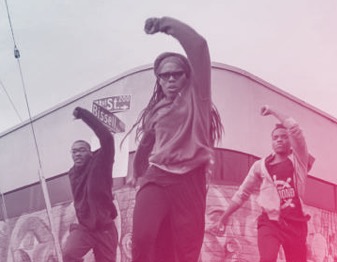Nevertheless, here we are. You have a gallery. You need art. You don’t know where to find it. You wrote to me. Your position leaves me scratching my head in perplexity, but help you I must. What you need is an education, and beyond the next four hundred words it’s going to be entirely self-directed. I can lead you to water, but the drinking is up to you.
Obviously, you have money, so for a quick start I suggest that you go to all the art fairs you can find. Art fairs are like supermarkets for art: you’ll look at a ton of product that has minimal shadings of difference. Occasionally you will cross paths with art that does not look like all the other art. That is the artist you want to represent. Take a friend with you, because art fairs are exhausting and you need to debrief with someone at the end of each day.

Gretchen Bender, Tracking the Thrill, 2013
Go to all the galleries in Brooklyn and Red Hook and Gowanus. The bigger artists who are already represented in New York are not going to work with you yet, because you are a (well-meaning) amateur. Also, the most interesting things happen at the peripheries of cities. Keep your eyes on the margins, because artists often produce good work when they’re not in the spotlight. Ask for studio visits and look for artists who have a steady practice. Don’t waste your time with assholes.
Talk to big-name artists who live in New York. Take them out to coffee and ask them whose work you should be looking at. Many of these artists also teach, and they come into contact with lots of artists whose practices deserve attention. Your gallery is somewhat medium specific, so I suggest that you also get in touch with the faculty chairs of local universities that have a department in that medium. They will know students and other faculty members whose work you can look at. They also come into contact with artists who are visiting from other cities, and will be able to point you in some interesting directions.

Gretchen Bender, Wild Dead, 2013
There are a few other things you need to think about. First, there are some ways in which you can support artists beyond selling their work. If you want to do cool things you have to be willing to stick your neck out, and at a time when many artists are forced to move out of major U.S. cities because of rising costs, it falls to all of us to work together to keep the creative economy moving. Once you do acquire some artists, consider finding a way to fund projects that aren’t commercially viable. Also, to preserve your sanity, you need a peer group, so cultivate friendships with some other gallerists in and beyond your neighborhood. These new friends will have great tips and can also help you find artists. Finally, go out and buy yourself a copy of Edward Winkleman‘s How to Start and Run a Commercial Gallery. Edward’s a straight shooter with lots of good advice, and the book should help you enormously. Good luck!





